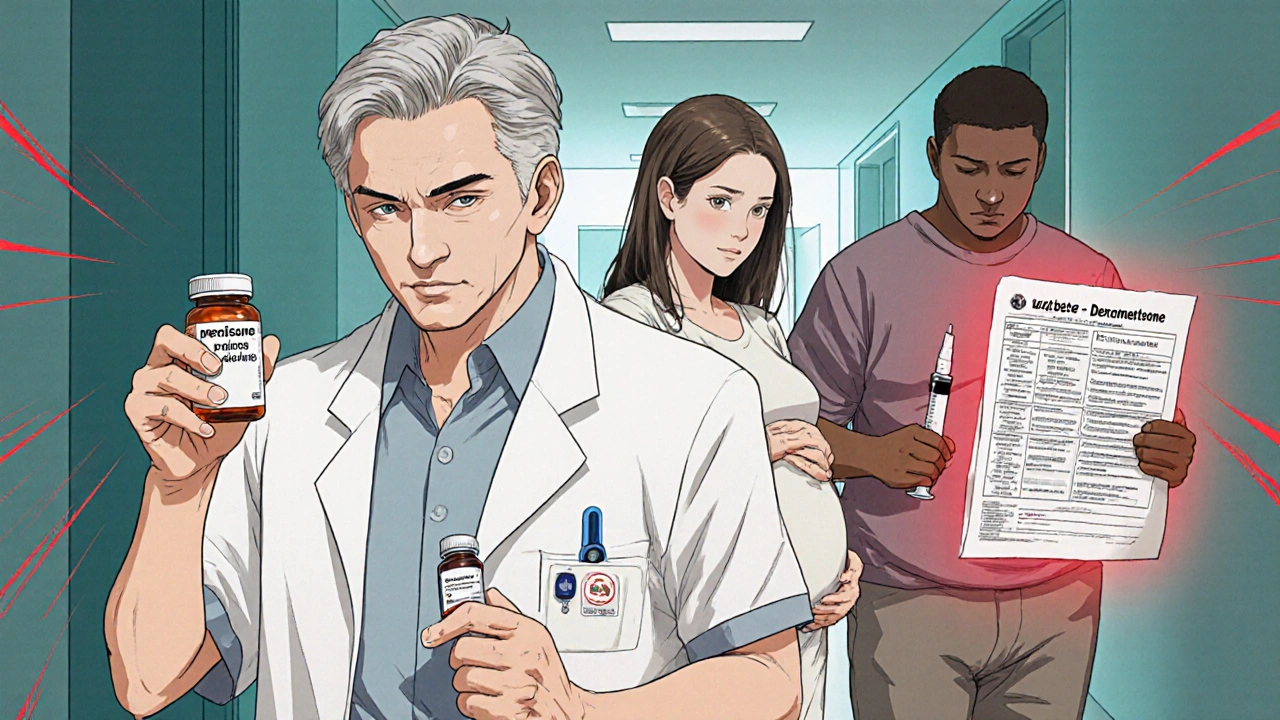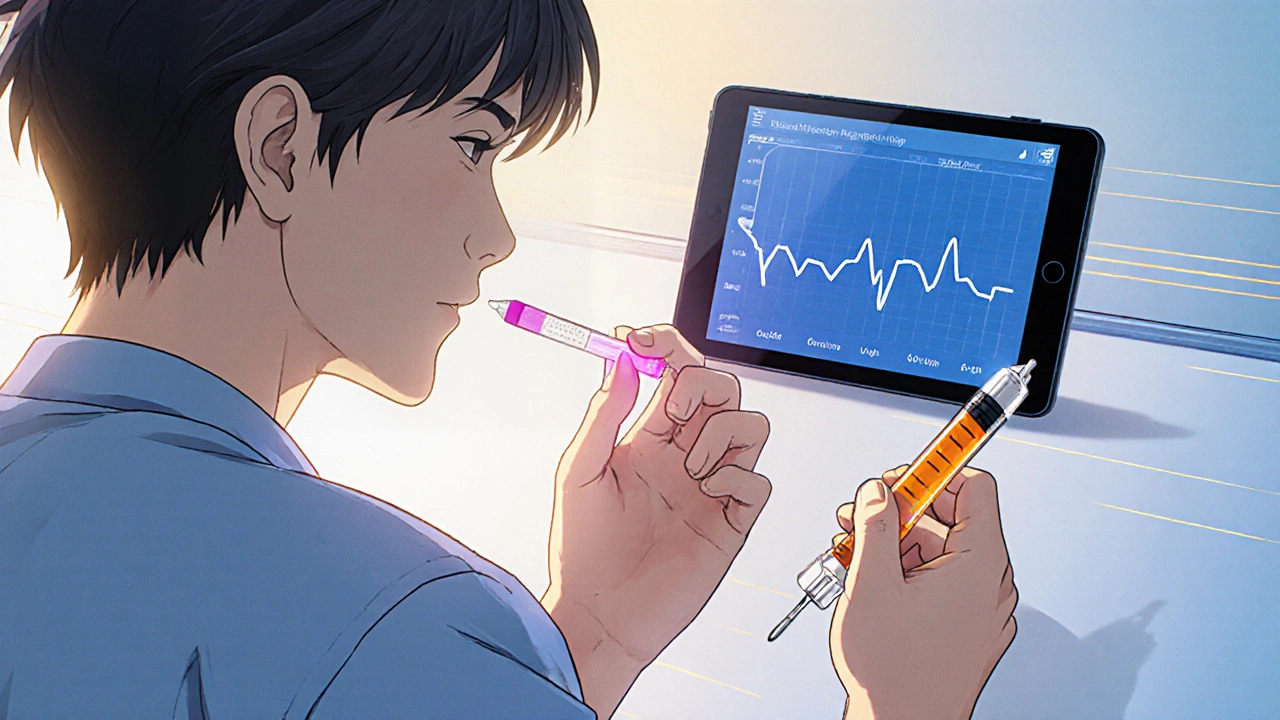
Steroid-Induced Hyperglycemia Risk Calculator
Steroid Risk Assessment
Results
Recommended Insulin Adjustments
Important Notes
Monitor glucose 4-8 hours after steroid dose. This tool provides guidance only - always consider patient-specific factors and clinical judgment.
Corticosteroids are synthetic glucocorticoids that mimic the body’s natural adrenal hormones and are prescribed for a wide range of inflammatory and autoimmune conditions. When they intersect with Diabetes - either pre‑existing or newly diagnosed - the metabolic fallout can be dramatic. In this guide we unpack why steroids raise blood sugar, which patients are most at risk, and how clinicians can keep glucose under control without compromising the anti‑inflammatory benefits.
Why steroids spike blood sugar
The link between Hyperglycemia and glucocorticoids is grounded in four physiological pathways:
- Increased hepatic glucose output: Steroids boost gluconeogenic enzymes such as phosphoenolpyruvate carboxykinase and glucose‑6‑phosphatase, lifting liver‑derived glucose by roughly 35‑40%.
- Insulin resistance in muscle: They blunt the GLUT4‑mediated glucose uptake, cutting muscle glucose transport by about 30% and reducing glycogen synthesis.
- Adipose‑derived free fatty acids: Lipolysis rises 25‑30%, flooding the bloodstream with non‑esterified fatty acids that further impair insulin signaling.
- Pancreatic β‑cell suppression: Direct inhibition of GLUT2 and glucokinase trims insulin secretion by 20‑35% and accelerates β‑cell fatigue.
These mechanisms act together, creating a dual hit of insulin resistance and impaired insulin release that is distinct from classic type‑2 diabetes.
Who is most likely to develop steroid‑induced diabetes?
Risk isn’t random - several patient‑specific and drug‑specific factors stack up:
- High‑dose Prednisone (≥7.5 mg/day) raises odds by >3‑fold.
- Dexamethasone is 6‑8 times more diabetogenic than prednisone at equivalent anti‑inflammatory doses.
- Body‑mass index ≥ 25 kg/m², age > 50 years, and a family history of diabetes each amplify risk two‑ to three‑fold.
- Prior gestational diabetes or chronic kidney disease (eGFR < 60 mL/min/1.73 m²) further heighten susceptibility.
- Each additional 5 mg of prednisone‑equivalent adds an 18 % risk increment; each extra week beyond the first two weeks of therapy adds ~12 %.
In practice, roughly 20‑50 % of patients on high‑dose systemic steroids develop clinically relevant hyperglycemia, and 10‑30 % of previously non‑diabetic individuals will be labeled with steroid‑induced diabetes.
Typical symptoms and why they’re often missed
Patients may present with classic diabetic cues - thirst, polyuria, fatigue - but those overlap with steroid side effects (increased appetite, weight gain, mood swings). Studies show:
- 65 % report excessive thirst, yet 40 % of hyperglycemic cases are discovered only through routine lab checks.
- Weight gain of 2.5‑4 kg in the first month is common, masking the underlying metabolic shift.
- Blurred vision and headache appear in 30‑40 % of cases, often attributed to the underlying disease rather than glucose rise.
Because of this symptom overlap, proactive glucose monitoring is essential.
Monitoring protocols that actually work
The NIH Practical Guide recommends a minimum of twice‑daily capillary glucose checks for anyone on prednisone ≥20 mg/day (or equivalent). Target thresholds:
- Fasting > 140 mg/dL (7.8 mmol/L) → consider pharmacologic therapy.
- Random > 180 mg/dL (10.0 mmol/L) → initiate treatment even if fasting is normal.
Timing matters: hyperglycemia peaks 4‑8 hours after a morning steroid dose, so a mid‑afternoon check often captures the highest reading.

Pharmacologic strategies
Therapy must address both insulin resistance and β‑cell dysfunction. The most common regimens include:
- Basal‑bolus insulin: Increase basal insulin by 20 % for each 10 mg of prednisone‑equivalent above 20 mg/day. Add rapid‑acting insulin at 1 U per 5‑10 g carbohydrate for meals.
- Sulfonylureas: Useful when oral therapy is preferred, but dose cautiously; risk of hypoglycemia rises during steroid taper.
- GLP‑1 receptor agonists: Emerging data (GLUCO‑STER trial) show lower hypoglycemia rates compared with basal‑bolus insulin, especially in patients with preserved renal function.
- Metformin: Helpful for insulin resistance but less effective when β‑cell suppression dominates.
Switch to oral agents once steroids are tapered below 10 mg/day and glucose stabilises for 3‑5 days.
Choosing the right steroid: dose, potency, and duration
| Steroid | Typical dose (mg/day) | Potency (relative to prednisone) | Hyperglycemia risk factor* | Half‑life (hours) |
|---|---|---|---|---|
| Prednisone | 5‑60 | 1× | Baseline | 12‑36 |
| Dexamethasone | 0.5‑9 | ≈6× | 6‑8× higher | 36‑72 |
| Methylprednisolone | 4‑48 | ≈1.25× | 1.3‑1.5× baseline | 12‑36 |
| Hydrocortisone | 20‑240 | 0.25× | Lower than prednisone | 8‑12 |
*Risk factor compared to an equivalent anti‑inflammatory dose of prednisone.
When possible, select the lowest‑potency steroid that achieves the therapeutic goal. A switch from dexamethasone to prednisone can halve the hyperglycemia risk without sacrificing efficacy in many chronic conditions.
Special considerations for specific patient groups
- Elderly: Reduced renal clearance amplifies steroid half‑life and insulin resistance; start monitoring at lower thresholds.
- Pregnant women: Steroid choice matters for fetal growth; prednisolone is preferred over dexamethasone, but glucose surveillance must be intensive.
- Patients with existing type‑2 diabetes: Expect a 50‑100 % rise in total daily insulin requirements. Adjust basal insulin first, then fine‑tune bolus doses.
- Hospitalized patients: Implement an automated order set that triggers glucose checks 2‑4 hours after each steroid dose and alerts the care team when readings exceed 180 mg/dL.

Future directions and emerging tools
Technology is already easing the burden. The European Association for the Study of Diabetes launched the STEROID‑Glucose app in 2023; users report a 32 % drop in hyperglycemic events thanks to real‑time insulin recommendations based on steroid dose.
Research into tissue‑selective glucocorticoid receptor modulators (e.g., XG‑201) promises anti‑inflammatory potency with a 65 % reduction in glucose‑raising side effects. If those agents gain approval, clinicians will have a “clean” steroid option, dramatically changing current management algorithms.
Key take‑aways for clinicians
- Screen every patient who starts systemic steroids for diabetes risk factors.
- Begin glucose monitoring within 24‑48 hours of the first dose; check at least twice daily.
- Apply the “20‑% basal‑increase per 10 mg prednisone‑equivalent” rule as a starting point.
- Reassess insulin needs when steroids are tapered; avoid lingering sulfonylureas that can cause hypoglycemia.
- Educate patients about symptom overlap and the temporary nature of steroid‑induced hyperglycemia.
Effective management hinges on early detection, tailored pharmacotherapy, and clear communication - all while preserving the therapeutic benefit of the corticosteroid.
Frequently Asked Questions
How quickly can steroids raise blood sugar?
Glucose can start climbing within 24‑48 hours of the first high‑dose steroid dose, with a peak usually 4‑8 hours after the morning dose.
Do I need insulin for every patient on steroids?
Not always. If fasting glucose stays below 140 mg/dL and the patient has mild risk factors, oral agents or close monitoring may suffice. Insulin is recommended when glucose exceeds 180 mg/dL or when the patient already has diabetes.
Can steroid‑induced diabetes become permanent?
In most cases, glucose returns to baseline within 3‑5 days after stopping the steroid. However, patients with underlying insulin resistance or pre‑diabetes may retain a higher long‑term risk and should be followed up regularly.
Is there a preferred oral medication?
Sulfonylureas work quickly but can cause hypoglycemia during steroid taper. GLP‑1 receptor agonists are gaining favor because they improve insulin sensitivity and carry a lower hypoglycemia risk, especially in patients with normal kidney function.
What monitoring frequency is recommended for out‑patients?
At least two checks per day (fasting and post‑prandial) for the first week of therapy, then daily fasting measurements if glucose remains stable.
By treating steroid‑induced hyperglycemia as a distinct clinical entity, clinicians can protect patients from serious complications while still delivering the anti‑inflammatory power they need. corticosteroids hyperglycemia management is achievable with vigilance, appropriate drug choice, and patient education.

Ben Durham
October 26, 2025 AT 15:05Thank you for putting together such a thorough guide on steroid‑induced hyperglycemia; it reads like a well‑structured textbook and will be invaluable for clinicians navigating this complex terrain.
First, the clear breakdown of the four physiological pathways offers a concise yet complete picture of why glucose levels can surge so dramatically.
The inclusion of concrete risk multipliers for different steroid potencies helps clinicians quantify risk in a real‑world setting.
I especially appreciate the practical advice on timing glucose checks 4‑8 hours after a morning dose, as this aligns perfectly with the pharmacokinetics of most systemic steroids.
The tables summarising dose equivalence and half‑life are a nice visual aid that many will find useful during round‑tables.
Providing specific thresholds for fasting and random glucose values gives a solid decision‑making framework without ambiguity.
Moreover, the stepwise pharmacologic algorithm-from basal‑bolus insulin adjustments to GLP‑1 agonists-covers the full therapeutic spectrum.
The recommendation to taper basal insulin by roughly 20 % for every 10 mg prednisone‑equivalent above 20 mg/day is both simple and evidence‑based.
In the special populations section, the emphasis on elderly renal function and pregnant women’s steroid choice demonstrates a nuanced understanding of patient heterogeneity.
The discussion of emerging tools like the STEROID‑Glucose app and selective glucocorticoid receptor modulators shows forward‑thinking that keeps the guide relevant for years to come.
Finally, the key take‑aways list distils the entire article into actionable bullet points, which is exactly what busy clinicians need at the bedside.
Overall, the guide balances depth with clarity, making it both a teaching resource and a quick reference.
I will certainly share this with my endocrinology colleagues and encourage them to adopt the monitoring protocol outlined here.
Keep up the excellent work; such comprehensive resources are vital for improving patient outcomes when steroids are unavoidable.
Thank you again for the effort and attention to detail.
Gary Campbell
October 26, 2025 AT 18:33What most people don’t realize is that the pharmaceutical giants have a hidden agenda when they push high‑dose steroids; they profit from the subsequent wave of chronic hyperglycemia that creates a new market for expensive diabetes drugs.
Every time a doctor follows the “standard” monitoring protocol, they unwittingly become a pawn in a larger scheme to keep patients dependent on medication.
It’s no coincidence that the guide emphasizes insulin adjustments while barely mentioning lifestyle interventions that could reduce the need for costly pharmaceuticals.
renee granados
October 27, 2025 AT 00:06Stop the lies! They hide the truth about steroids and blood sugar on purpose.
All this “guidance” is just a front for pushing more drugs onto us.
People need to see the real danger and demand alternatives now.
Stephen Lenzovich
October 27, 2025 AT 22:20While the guide is undeniably comprehensive, one must question whether the emphasis on insulin therapy reflects a bias toward Western medical practices that prioritize pharmaceuticals over holistic care.
Are we truly considering non‑pharmacologic options with the same rigor?
It would be refreshing to see a deeper exploration of dietary modulation and exercise regimens tailored to steroid‑induced metabolic stress.
Nevertheless, the data presented on GLP‑1 agonists is impressive and aligns with recent trials showing reduced hypoglycemia.
Overall, the article stands as a robust resource, albeit one that could benefit from a broader perspective beyond drug‑centric solutions.
asha aurell
October 28, 2025 AT 01:06The guide is overly wordy and misses the point.
Miracle Zona Ikhlas
October 28, 2025 AT 05:16I agree that the guide hits the key markers, and I especially like the clear step‑by‑step insulin adjustment table; it will make it much easier for busy clinicians to act quickly.
Sharing this with my team has already sparked some useful discussions about early monitoring.
naoki doe
October 29, 2025 AT 02:06When my aunt was on a high‑dose steroid regimen last year, we barely checked her sugars and she ended up in the ER with a ketoacidosis episode.
It made me realize how critical proper monitoring is, and I think many families are unaware of these risks.
Personal experiences like this underscore the need for clear patient education alongside the clinical guidelines.
sarah basarya
October 29, 2025 AT 06:16This article is a disgrace; it glosses over the systemic failures that let steroid‑induced diabetes proliferate while offering half‑baked solutions.
The medical community should be ashamed for allowing patients to suffer avoidable complications.
We need a radical overhaul of how we approach steroid prescribing, not just another checklist.